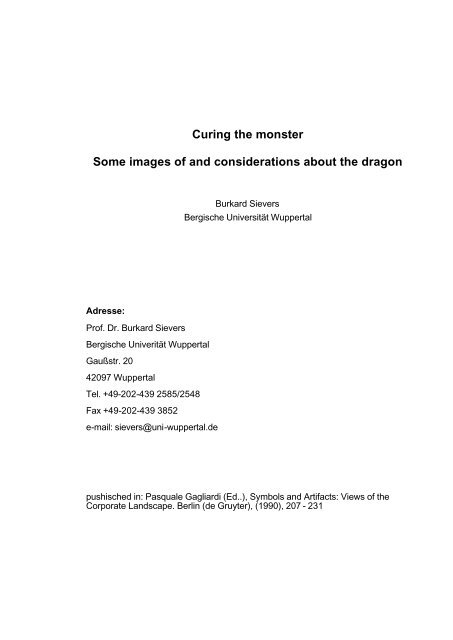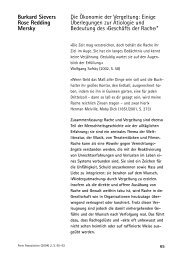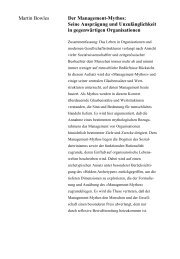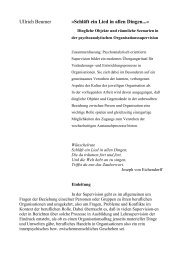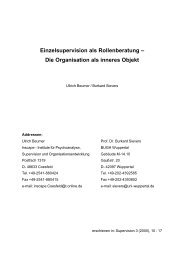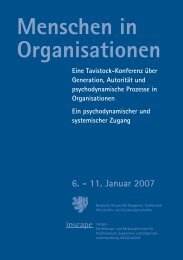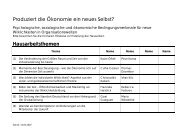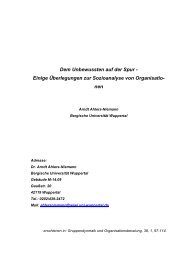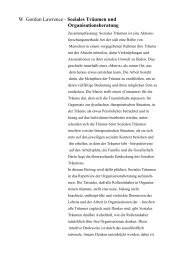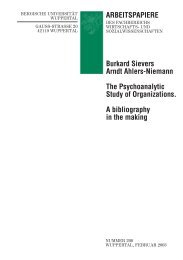Curing the monster Some images of and considerations - Prof. Dr ...
Curing the monster Some images of and considerations - Prof. Dr ...
Curing the monster Some images of and considerations - Prof. Dr ...
Create successful ePaper yourself
Turn your PDF publications into a flip-book with our unique Google optimized e-Paper software.
<strong>Curing</strong> <strong>the</strong> <strong>monster</strong><br />
<strong>Some</strong> <strong>images</strong> <strong>of</strong> <strong>and</strong> <strong>considerations</strong> about <strong>the</strong> dragon<br />
Burkard Sievers<br />
Bergische Universität Wuppertal<br />
Adresse:<br />
Pr<strong>of</strong>. <strong>Dr</strong>. Burkard Sievers<br />
Bergische Univerität Wuppertal<br />
Gaußstr. 20<br />
42097 Wuppertal<br />
Tel. +49-202-439 2585/2548<br />
Fax +49-202-439 3852<br />
e-mail: sievers@uni-wuppertal.de<br />
pushisched in: Pasquale Gagliardi (Ed..), Symbols <strong>and</strong> Artifacts: Views <strong>of</strong> <strong>the</strong><br />
Corporate L<strong>and</strong>scape. Berlin (de Gruyter), (1990), 207 - 231
- 1 -<br />
"The dragon was evolved along<br />
with civilization itself"<br />
(Smith 1919: 76).<br />
"The artefacts <strong>of</strong> culture can<br />
be understood as defense<br />
systems that help to create<br />
<strong>the</strong> illusion that we are<br />
greater <strong>and</strong> more powerful than<br />
we actually are"<br />
(Morgan 1986: 213).<br />
1. On <strong>the</strong> way into <strong>the</strong> dragon's cave<br />
riting about <strong>and</strong> reflecting upon <strong>the</strong> dragon has become an ongoing venture<br />
for me since I decided to choose it as <strong>the</strong> object <strong>of</strong> my presentation at <strong>the</strong><br />
Milano conference on corporate artifacts in 1987. Once I had allowed this creature<br />
to enter into my mind <strong>and</strong> given it some space in my <strong>of</strong>fice it somehow began to<br />
crawl all over <strong>the</strong> place; dragons eventually were everywhere, in cartoons, in fairytales,<br />
legends, in advertisements, in churches, in mythology, in children books. And<br />
<strong>the</strong> more I let my friends know what a curious creature I had in my mind I received<br />
post-cards, newspaper articles <strong>and</strong> even a record with <strong>the</strong> famous song from<br />
Peter, Paul <strong>and</strong> Mary: 'Puff, <strong>the</strong> magic dragon'. It is <strong>the</strong> story <strong>of</strong> little Jackie Paper<br />
who shared part <strong>of</strong> his childhood with Puff, <strong>the</strong> gigantic dragon, till he eventually left<br />
<strong>the</strong> dragon when it made way for o<strong>the</strong>r toys.<br />
No later than when I first had listened to this song, I decided to play it at <strong>the</strong><br />
beginning <strong>of</strong> my presentation which I was going to prepare. But when I did so it<br />
happened that <strong>the</strong> sound <strong>of</strong> <strong>the</strong> small tape recorder was by far not loud enough for<br />
<strong>the</strong> auditorium. Then, to my big surprise, when I nearly had switched <strong>the</strong> music <strong>of</strong>f,<br />
<strong>the</strong> people in <strong>the</strong> room suddenly began to sing <strong>the</strong> song <strong>of</strong> Puff, <strong>the</strong> magic dragon;<br />
first s<strong>of</strong>tly as if <strong>the</strong>y didn't dare to trust <strong>the</strong>mselves <strong>and</strong> <strong>the</strong>n, <strong>the</strong> more <strong>the</strong>y began to<br />
enjoy it, ra<strong>the</strong>r loud. Can you imagine, some hundred colleagues ga<strong>the</strong>red in an<br />
auditorium <strong>of</strong> a famous Catholic University singing a song about <strong>the</strong> dragon like<br />
children ? There it was, in <strong>the</strong> middle <strong>of</strong> <strong>the</strong> audience, <strong>the</strong> dragon!
- 2 -<br />
The more I allowed <strong>the</strong> dragon to enter into my space <strong>the</strong> more I made <strong>the</strong><br />
experience that this creature allowed me to cross boundaries, time boundaries as<br />
well as cultural ones. Not only that I rediscovered that previously in my life, as a<br />
boy-scout, <strong>the</strong>re had been a time in which <strong>the</strong> dragon already had quite some<br />
significance for me as I identified myself with St. George, <strong>the</strong> hero. Very soon it<br />
also became obvious to me that <strong>the</strong> dragon not only is as old as mankind but more<br />
or less a universal creature which, despite its various meanings, can be found in<br />
nearly all cultures. Like <strong>the</strong> chimera, <strong>the</strong> centaur or <strong>the</strong> sphynx <strong>the</strong> dragon is a<br />
creature <strong>of</strong> <strong>the</strong> imagination. The question whe<strong>the</strong>r such an imaginary creature will<br />
be regarded as unreal or as real soon leads one into deeper areas <strong>of</strong> philosophy<br />
<strong>and</strong> <strong>of</strong> epistemology, in particular. Although at present <strong>the</strong>re can be no doubt that<br />
<strong>the</strong> dragon is an artifact, created <strong>and</strong> brought into life through art, during previous<br />
millenia it <strong>of</strong>ten had <strong>the</strong> same reality as gods, angels, devils, ghosts, fairies <strong>and</strong><br />
o<strong>the</strong>r beings. Today we may be convinced that <strong>the</strong>re is no such a thing as a<br />
dragon <strong>and</strong> that dragons never really existed, but never<strong>the</strong>less we are surrounded<br />
by countless symbolic representations which prove that <strong>the</strong>re were times in which<br />
our predecessors considered dragons to be as real as ei<strong>the</strong>r <strong>the</strong> particular hero<br />
who attempted to kill it or <strong>the</strong> horse he rode upon.<br />
Overtime, <strong>the</strong> more I tried to take <strong>the</strong> dragon seriously <strong>the</strong> more I became<br />
confused with <strong>images</strong> <strong>and</strong> perceptions, previously taken for granted, <strong>of</strong> what reality<br />
was supposed to be. If, for example, according to contemporary Christian belief <strong>of</strong><br />
<strong>the</strong> existence <strong>of</strong> God, <strong>the</strong> saints <strong>and</strong> <strong>the</strong> angels is supposed to be real but not <strong>the</strong><br />
existence <strong>of</strong> <strong>the</strong> great red dragon with seven heads <strong>and</strong> ten horns which is<br />
described in <strong>the</strong> Revelation <strong>of</strong> John (cf. Rosenberg 1956: 207 ff.), what are <strong>the</strong>n<br />
<strong>the</strong> 'criteria' to discriminate <strong>the</strong> real from <strong>the</strong> unreal? Similar is <strong>the</strong> case <strong>of</strong> St.<br />
George whose historic existence eventually was negated by <strong>the</strong> church. What<br />
about all <strong>the</strong> good works which have been accomplished by thous<strong>and</strong>s <strong>of</strong><br />
Christians for his glory; are <strong>the</strong>y less real after <strong>the</strong> annihilation <strong>of</strong> this saint? And if,<br />
on <strong>the</strong> o<strong>the</strong>r h<strong>and</strong>, <strong>the</strong> dragon will be regarded as a symbolization <strong>of</strong> a part <strong>of</strong><br />
human reality which o<strong>the</strong>rwise cannot be grasped or described, what <strong>the</strong>n is that<br />
reality about? Is it a real reality, an unreal or even a false one?
- 3 -<br />
But before I go fur<strong>the</strong>r into what I came up with on my attempt to cure <strong>the</strong> <strong>monster</strong> it<br />
seems to be important to illustrate what I had in mind when, on <strong>the</strong> occasion <strong>of</strong> this<br />
conference, I decided to approach <strong>the</strong> dragon. This choice had to do with <strong>the</strong> fact<br />
that this was a SCOS-Conference in at least two ways. On <strong>the</strong> one h<strong>and</strong>, at <strong>the</strong><br />
First International Conference <strong>of</strong> SCOS (St<strong>and</strong>ing Conference <strong>of</strong> Organizational<br />
Symbolism) which I attended at Lund in 1984 <strong>the</strong> conference poster showed a<br />
beautiful fascinating dragon coming through <strong>the</strong> strong lines <strong>of</strong> an organigram.<br />
Figure 1: SCOS Poster, The First International Conference on Organization<br />
Symbolism <strong>and</strong> Corporate Culture<br />
Since <strong>the</strong>n <strong>the</strong> dragon has become <strong>the</strong> 'logo' <strong>of</strong> this network <strong>of</strong> social scientists, an<br />
autonomous work-group within EGOS, <strong>the</strong> European Group <strong>of</strong> Organization<br />
Studies; from 1985 to 1987 <strong>Dr</strong>agon was <strong>the</strong> title <strong>of</strong> <strong>the</strong> journal <strong>of</strong> SCOS. At <strong>the</strong><br />
same time my wish to become more concerned with <strong>the</strong> dragon was guided by <strong>the</strong><br />
'slogan' <strong>of</strong> SCOS: "We do it for fun!" And as a matter <strong>of</strong> fact quite some fun it was<br />
both searching for dragons as well as presenting part <strong>of</strong> my results on <strong>the</strong><br />
occasion <strong>of</strong> <strong>the</strong> Milano conference.<br />
It seems that what I came up with out <strong>of</strong> this particular search is tw<strong>of</strong>old: It is a<br />
piece <strong>of</strong> research on <strong>the</strong> logo <strong>of</strong> a particular organization, but it also is <strong>the</strong><br />
expression <strong>of</strong> how an organization member acts within <strong>the</strong> process <strong>of</strong><br />
intersubjective constructions <strong>of</strong> reality <strong>and</strong> its meaning. As I cannot hide that I am a<br />
member <strong>of</strong> this particular institution <strong>the</strong> following results <strong>and</strong> reflections may also<br />
show how a particular SCOS-member used his own impact <strong>and</strong> authority to<br />
explain <strong>and</strong> describe what appears to him as a pursuable interpretation <strong>of</strong><br />
organizational reality. As in any o<strong>the</strong>r organization such an individual interpretation<br />
seldom is a solipsistic one; it normally is rooted in <strong>the</strong> institutional history <strong>and</strong><br />
tradition <strong>and</strong> related to o<strong>the</strong>r members representing as such ei<strong>the</strong>r a mainstream<br />
approach <strong>of</strong> thinking or a more deviant one.<br />
So far as SCOS <strong>and</strong> its short history is concerned <strong>the</strong> notion propagated here <strong>of</strong><br />
curing <strong>the</strong> <strong>monster</strong> instead <strong>of</strong> killing or taming it in itself <strong>and</strong> in this particular<br />
institutional context never was a prominant or revolutionary one. As Rein Nauta
- 4 -<br />
(1986: 6) states, in <strong>the</strong> history <strong>of</strong> SCOS <strong>the</strong>re is a reversal <strong>of</strong> <strong>the</strong> ancient hero myth<br />
in which "<strong>the</strong> hero fights a struggle against a reality which is different from what he<br />
wants it to be... Reminding one <strong>of</strong> that fairy-tale written down by <strong>the</strong> Grimm<br />
bro<strong>the</strong>rs <strong>of</strong> <strong>the</strong> young man who travelled into <strong>the</strong> world in order to learn what horror<br />
was, at <strong>the</strong> beginning <strong>of</strong> SCOS some young <strong>and</strong> daring scholars went into<br />
academia not to fight <strong>the</strong> dragon, but to find him. Researching <strong>the</strong> dragon <strong>the</strong>y<br />
enacted a revaluing <strong>of</strong> values (an 'Umwertung aller Werte' - a paradigm change),<br />
because <strong>the</strong>y tried to use <strong>the</strong> treasure <strong>of</strong> rationality, <strong>of</strong> choice, <strong>of</strong> consciousness as<br />
an instrument for finding <strong>the</strong> dragon. On <strong>the</strong> road to <strong>the</strong> dragon-country, <strong>the</strong><br />
promised l<strong>and</strong> <strong>of</strong> life <strong>and</strong> underst<strong>and</strong>ing, we made some friends <strong>and</strong> met quite a<br />
few fellow-travellers .... One interpretation <strong>of</strong> <strong>the</strong> ways <strong>of</strong> SCOS is that <strong>of</strong> a<br />
religious quest, in search <strong>of</strong> <strong>the</strong> truth <strong>of</strong> organization life".<br />
"It is generally assumed", as P. O. Berg (1984: 4), <strong>the</strong> first chairman, put it, "that<br />
SCOS was created in <strong>the</strong> bar <strong>of</strong> Strathclyde Business School, <strong>the</strong> last evening <strong>of</strong><br />
<strong>the</strong> EGOS 1981 Colloquium" in Glasgow. As a matter <strong>of</strong> fact, it was only a small<br />
group expressing <strong>the</strong>ir common interest in 'organizational symbolism', using it<br />
somehow as a container for a possible broader methodological <strong>and</strong><br />
interdisciplinary variety <strong>of</strong> organizational research. When after two smaller<br />
conferences in Exeter <strong>and</strong> Groningen <strong>the</strong> First International Conference was set up<br />
at Lund University in 1984 already more than 200 people from a whole variety <strong>of</strong><br />
countries attended. Despite its increasing membership SCOS has succeeded in<br />
remaining a network in its true sense over <strong>the</strong> years; it only has a very minimal<br />
organizational infrastructure <strong>and</strong> is primarily carried by its members' initiatives; it<br />
emphasizes "<strong>the</strong> importance <strong>of</strong> personal interactions in an open <strong>and</strong> nonevaluative<br />
atmosphere" (Nauta 1984: 7). Quite unusual or even superfluous for normal<br />
scientific associations, in SCOS "<strong>the</strong> shared attitudes <strong>of</strong> support <strong>and</strong> tolerance ...<br />
have left room for <strong>the</strong> individual, <strong>the</strong> spontaneous <strong>and</strong> <strong>the</strong> unpredictable<br />
performance" (Kreiner 1987: 17).<br />
2. <strong>Dr</strong>aconology or <strong>the</strong> science <strong>of</strong> dragons: <strong>Some</strong> facts <strong>and</strong> figures
- 5 -<br />
Before we begin <strong>the</strong> journey into <strong>the</strong> mythology <strong>of</strong> <strong>the</strong> dragon, its various <strong>images</strong>,<br />
<strong>and</strong> <strong>the</strong>ir symbolism it appears, appropriate to inspect some facts <strong>and</strong> figures<br />
through which <strong>the</strong> existence, quality, <strong>and</strong> dissemination <strong>of</strong> dragons may be proved.<br />
From such a 'scientific' perspective enough evidence must be provided in order to<br />
confirm <strong>the</strong> truth that <strong>the</strong> dragon is a primeval, universal <strong>and</strong> real phenomenon:<br />
The dragon belongs to <strong>the</strong> wider family <strong>of</strong> snakes <strong>and</strong> serpents, as such it is much<br />
older than mankind. Contrary to men, dragons are creatures <strong>of</strong> chaos (Redaktion<br />
... 1985: 13). As can be learned from various accounts <strong>of</strong> <strong>the</strong> creation <strong>of</strong> <strong>the</strong> world,<br />
dragons have existed since <strong>the</strong> first days <strong>of</strong> <strong>the</strong> genesis.<br />
<strong>Dr</strong>agons are born from eggs which usually have <strong>the</strong> size <strong>of</strong> two man's fists.<br />
Especially during infancy <strong>the</strong>ir predominant living space is water; different species<br />
prefer lakes, swamps, rivers, or <strong>the</strong> seaside. At least for <strong>the</strong> Chinese version <strong>of</strong> <strong>the</strong><br />
dragon it can be proved that dragons take about 1500 years to grow up to <strong>the</strong>ir full<br />
length, ano<strong>the</strong>r 500 years till <strong>the</strong>ir characteristic horns develop <strong>and</strong> again ano<strong>the</strong>r<br />
1000 years till <strong>the</strong>ir wings are formed (Redaktion ... 1985: 44). Descriptions <strong>of</strong><br />
dragons were seldom accurate, because those who happened to meet a dragon<br />
were so scared that <strong>the</strong>y could only remember one or <strong>the</strong> o<strong>the</strong>r <strong>of</strong> its horrible parts<br />
without any fur<strong>the</strong>r perception <strong>of</strong> its gestalt (Redaktion ... 1985: 95). Although it<br />
seems to be true that no one dragon equals <strong>the</strong> o<strong>the</strong>r (Mode 1983: 120), dragons<br />
predominantly consist <strong>of</strong> <strong>the</strong> following elements: <strong>the</strong> jawbones <strong>of</strong> a crocodile, <strong>the</strong><br />
teeth <strong>of</strong> a lion, <strong>the</strong> wings <strong>of</strong> a bat, <strong>the</strong> legs <strong>of</strong> a lizard, <strong>the</strong> claws <strong>of</strong> an eagle, <strong>the</strong><br />
body <strong>of</strong> a python <strong>and</strong> <strong>the</strong> horns <strong>of</strong> a bull (Redaktion ... 1985: 14).<br />
<strong>Dr</strong>agons are disseminated all over <strong>the</strong> world; detailed maps prove, for example,<br />
<strong>the</strong> dragon places in Middle Europe (Redaktion ... 1985: 78 f.; Vinycomb 1906: 79<br />
ff.).<br />
As Dickinson (1981: 75), for instance, indicates, <strong>the</strong>re are at least 60 places in<br />
Europe which derive <strong>the</strong>ir names from <strong>the</strong> dragon, such as <strong>Dr</strong>akenburg<br />
(<strong>Dr</strong>agonburgh), Wurmlingen (named after a big worm which was <strong>the</strong> original<br />
Germanic word for dragon, as in Lindwurm) or Klagenfurt (a town in Austria which<br />
derives its name from <strong>the</strong> wailing which was heard when <strong>the</strong> town was destroyed
- 6 -<br />
by a dragon, a tragedy which is depicted by <strong>the</strong> huge monument in <strong>the</strong> town<br />
center).<br />
From <strong>the</strong>ir historical evolution dragons can be classified into two main categories:<br />
<strong>the</strong> cosmic <strong>and</strong> <strong>the</strong> mythological dragons; <strong>the</strong> latter are <strong>of</strong>ten <strong>the</strong>n subdivided into<br />
modern <strong>and</strong> psychic ones. Cosmic dragons cannot be regarded as animals in <strong>the</strong><br />
literal sense, <strong>the</strong>y were incarnations <strong>of</strong> <strong>the</strong> chaos, <strong>the</strong>y are direct descendents <strong>of</strong><br />
<strong>the</strong> Titanes who lived before time. Contrary to <strong>the</strong>ir predecessors <strong>the</strong> modern<br />
mythodragons were natural creatures; <strong>the</strong>y housed in caverns <strong>and</strong> canyons, curled<br />
around mountains <strong>and</strong> ancient mounds, leaving behind <strong>the</strong>m stink <strong>and</strong> slime; <strong>the</strong>y<br />
crawled through <strong>the</strong> woods <strong>and</strong> mixed with <strong>the</strong> ghosts <strong>of</strong> sources <strong>and</strong> rivers<br />
(Redaktion ... 1985: 76). The psychic mythodragons, which seem to be <strong>the</strong> most<br />
Figure 2: Matthäus Merina, sen., Merians Welt der Tiere, Nördlingen (Greno)<br />
1985<br />
interesting ones in <strong>the</strong> context <strong>of</strong> <strong>the</strong> symbolics <strong>of</strong> artifacts are inhabitants <strong>of</strong> <strong>the</strong><br />
human inner world. As <strong>the</strong>y <strong>of</strong>ten cannot be acknowledged as such, <strong>the</strong>y have to<br />
be projected into objects <strong>of</strong> <strong>the</strong> outer world (Steffen 1984: 7). - It seems to me that<br />
post-modern mythodragons can be neglected so far because <strong>the</strong>y only are<br />
allusions to certain elements deriving from ancient styles.<br />
As dragons nowadays are becoming more <strong>and</strong> more rare <strong>the</strong> fact that SCOS has<br />
chosen <strong>the</strong> dragon as its emblem can be regarded as akin to <strong>the</strong> p<strong>and</strong>a <strong>of</strong> <strong>the</strong><br />
World Wildlife Fund. As for <strong>the</strong> p<strong>and</strong>a <strong>the</strong> days <strong>of</strong> <strong>the</strong> dragons are numbered; as it<br />
has no chance to survive in normal hunting-grounds it not only has to be protected,<br />
but eventually will be bred in special zoological gardens. Perhaps one could even<br />
gain <strong>the</strong> Queen's husb<strong>and</strong>, <strong>the</strong> Duke <strong>of</strong> Edinburgh, as honorary president <strong>of</strong><br />
SCOS. As Engl<strong>and</strong> has had St. George, who obviously was one <strong>of</strong> <strong>the</strong><br />
predominant instigators <strong>of</strong> dragon killing, as its national saint for so many<br />
centuries, this could be an important act <strong>of</strong> reaparation.<br />
3. How to cope with a dragon? Five pragmatic ways
- 7 -<br />
Whereas <strong>the</strong> pro<strong>of</strong> <strong>of</strong> <strong>the</strong> dragon's existence is more a matter for scientists or<br />
researchers, <strong>the</strong> question <strong>of</strong> how to h<strong>and</strong>le a dragon leads us into <strong>the</strong> fields <strong>of</strong><br />
scholars. As Cooper states, "<strong>the</strong> scholar cultivates <strong>the</strong> critical spirit <strong>of</strong> <strong>the</strong><br />
'humanistic sciences'" (Cooper 1983: 721) which "answer <strong>the</strong> central question<br />
<strong>of</strong> men's collective existence <strong>and</strong> <strong>of</strong> individual life history. Their <strong>the</strong>mes are<br />
justice <strong>and</strong> freedom, violence <strong>and</strong> oppression, happiness <strong>and</strong> gratification,<br />
poverty, illness, <strong>and</strong> death. Their categories are victory <strong>and</strong> defeat, love <strong>and</strong><br />
hate, salvation <strong>and</strong> damnation" (Habermas 1971: 96).<br />
From such a broader perspective <strong>the</strong>re are at least five predominant ways <strong>of</strong><br />
treating a dragon:<br />
1. The heroic way: "You have to kill him!"<br />
2. The magic solution: "Kiss him!"<br />
3. The Chinese version: "It is <strong>the</strong> emperor <strong>of</strong> wisdom <strong>and</strong><br />
rain!"<br />
4. The science fiction approach: "Ride him!"<br />
5. The lonely child solution: "Let's be friends!"<br />
Out <strong>of</strong> <strong>the</strong>se five versions, <strong>the</strong> heroic solution <strong>of</strong> killing <strong>the</strong> dragon obviously is <strong>the</strong><br />
predominant one in our western tradition. The magic creators <strong>of</strong> <strong>the</strong> SCOS logo<br />
around P. O. Berg have deliberately not chosen <strong>the</strong> image <strong>of</strong> <strong>the</strong> knight fighting <strong>the</strong><br />
dragon because that would have given "too much power to <strong>the</strong> knight as being a<br />
symbol <strong>of</strong> <strong>the</strong> victory <strong>of</strong> <strong>the</strong> modern technocratic society over <strong>the</strong> primitive <strong>and</strong><br />
instinctive dimensions <strong>of</strong> life" (Berg 1987a). Ano<strong>the</strong>r, obviously unconscious<br />
reason for <strong>the</strong>ir choice could have been that e.g. <strong>the</strong> image <strong>of</strong> St. George would<br />
have been too reminiscent <strong>of</strong> <strong>the</strong> Order <strong>of</strong> <strong>the</strong> Garter which <strong>the</strong>n probably would<br />
have been in collusion with SCOS' predominant myth <strong>of</strong> an open network.<br />
Although I favour such a creative attempt at organizational mythmaking, it appears<br />
to be important to elucidate a bit fur<strong>the</strong>r <strong>the</strong> image <strong>of</strong> <strong>the</strong> dragon fight which as<br />
such is as old as mankind. The legend <strong>of</strong> St. George seems to be a good example<br />
to begin with because <strong>the</strong> history <strong>of</strong> his relation to <strong>the</strong> dragon not only has a
- 8 -<br />
relatively clear origin but also a significant relevance as a symbol <strong>of</strong> many<br />
European nations. As he was <strong>the</strong> patron saint <strong>of</strong> all those who had devoted <strong>the</strong>ir<br />
lives to fighting, St. George was also <strong>the</strong> patron <strong>of</strong> <strong>the</strong> crusaders. They obviously<br />
were <strong>the</strong> ones who brought <strong>the</strong> image <strong>of</strong> St. George as <strong>the</strong> dragon fighter back. It<br />
<strong>the</strong>n ultimately became a constituent part <strong>of</strong> his iconography through Jacobus de<br />
Voragine a dominican <strong>and</strong> archbishop <strong>of</strong> Genua, who, in <strong>the</strong> 13. century, included<br />
this legend into his 'Legenda Aurea' (Golden Legend) which was <strong>of</strong> great influence<br />
on folkloristic piety (Braunfels-Esche 1976: 21 ff.; Egli 1982: 223 ff.). Although<br />
St.George did not <strong>of</strong>ficially become <strong>the</strong> national patron <strong>of</strong> Engl<strong>and</strong> until 1347, his<br />
feast, <strong>the</strong> 23rd <strong>of</strong> April, received <strong>the</strong> same rank as <strong>the</strong> great feasts <strong>of</strong> <strong>the</strong><br />
ecclesiastical year through a synod at Oxford in 1222. Around that time he also<br />
became <strong>the</strong> national patron <strong>of</strong> Georgia, Greece, Russia, Hungary, Pol<strong>and</strong> <strong>and</strong><br />
Sweden; in Germany he was <strong>the</strong> patron <strong>of</strong> <strong>the</strong> nobility.<br />
Figure 3: Albreht Dürer, St. George killing <strong>the</strong> dragon. Woodcot ca. 1501/04<br />
That <strong>the</strong> dragon became <strong>the</strong> incarnation <strong>of</strong> evil, <strong>the</strong> enemy <strong>and</strong> <strong>of</strong>ten enough <strong>the</strong><br />
devil in Christian mythology during <strong>the</strong> last millenium not only became evident<br />
through thous<strong>and</strong>s <strong>of</strong> churches which were dedicated to St. George all over<br />
Europe but also through <strong>the</strong> fact that <strong>the</strong> legends <strong>of</strong> nearly 60 saints are based,<br />
one way or <strong>the</strong> o<strong>the</strong>r, on dragon killing (Aufhauser 1911: 239); among <strong>the</strong>m are<br />
also women who like St. Martha vanquished <strong>the</strong> dragon with holy water or St.<br />
Margaretha who became <strong>the</strong> patron <strong>of</strong> pregnant women, because, when she was<br />
swallowed by <strong>the</strong> dragon, <strong>the</strong> cross which she was wearing grew till it finally burst<br />
<strong>the</strong> <strong>monster</strong> (Redaktion ... 1985: 95; cf. Roheim 1972: 299).<br />
That <strong>the</strong> dragon also has a long tradition in our western military history is, for<br />
example, indicated by <strong>the</strong> 'dragons', <strong>the</strong> French cavalrymen in <strong>the</strong> Thirty Years<br />
War, who were equipped with small-arms called 'fire-spitting dragons'; it seems<br />
that <strong>the</strong> fact that, for example, <strong>the</strong> English, French, German, <strong>and</strong> <strong>the</strong> Swedish<br />
language have incorporated <strong>the</strong> Latin 'draco' (which was taken from <strong>the</strong> Greek<br />
'drakon'), originates from <strong>the</strong> dragon as a cohort sign <strong>of</strong> <strong>the</strong> Romans which <strong>the</strong>y<br />
<strong>the</strong>mselves had adopted from <strong>the</strong>ir Teutonic enemies (Höfler 1961: 99). The selfidentification<br />
with <strong>the</strong> dragon in order to put one's enemies to flight is in itself a
- 9 -<br />
symbolic act which e.g. can be found among <strong>the</strong> ancient Persians, who wore<br />
dragon helmets, or among <strong>the</strong> Vikings, whose ship bows were shaped like a<br />
dragon, a symbol which was later put on <strong>the</strong> church ro<strong>of</strong> as protection against <strong>the</strong><br />
demons. "In <strong>the</strong> sign <strong>of</strong> <strong>the</strong> dragon <strong>the</strong>y were conquering <strong>the</strong> dragon" (Steffen<br />
1984: 30).<br />
In addition to St. George some fur<strong>the</strong>r names <strong>and</strong> <strong>images</strong> may indicate how<br />
primeval <strong>and</strong> universal <strong>the</strong> heroic way <strong>of</strong> coping with a dragon is. There is, for<br />
example, <strong>the</strong> mythical story <strong>of</strong> <strong>the</strong> nordic hero Sigurd who when he killed <strong>the</strong><br />
dragon on behalf <strong>of</strong> a dwarf realized only by chance that one single drop <strong>of</strong> <strong>the</strong><br />
dragon's blood gave man <strong>the</strong> knowledge about <strong>the</strong> primeval things on earth. One<br />
also may be reminded what happened to Siegfried, his Germanic namesake, who<br />
took a bath in <strong>the</strong> dragon's blood in order to get <strong>the</strong> strength <strong>of</strong> <strong>the</strong> dragon himself.<br />
The epos <strong>of</strong> Beowulf <strong>and</strong> Wiglaf (Redaktion ... 1985: 7 ff.) or that <strong>of</strong> <strong>the</strong> Golden<br />
Fleece are o<strong>the</strong>r examples that <strong>the</strong> dragon had to be slaughtered in order to<br />
receive <strong>the</strong> enormous treasure which he kept in custody. Ancient Egyptian<br />
mythology contains a fur<strong>the</strong>r image <strong>of</strong> <strong>the</strong> dragon fight. It is <strong>the</strong> sun-god Re who<br />
accompanied by his hyena faced guard Seth moved across <strong>the</strong> Egyptian sky in his<br />
shining barque, keeping away <strong>the</strong> dragon Apep who reigned over darkness<br />
striving to annihilate <strong>the</strong> god <strong>of</strong> light.<br />
Figure 4: Seth, <strong>the</strong> guard <strong>of</strong> <strong>the</strong> sun-god Re, Fighting at <strong>the</strong> bow <strong>of</strong> <strong>the</strong> shining<br />
barque against <strong>the</strong> gaiant-serpent Apophis. Papyros 21. Dynasty (1085-950 B.C.);<br />
from Steffen 1984: 48<br />
Out <strong>of</strong> all <strong>the</strong> stories <strong>and</strong> legends on dragon fighting I, however, prefer most <strong>the</strong><br />
one <strong>of</strong> Sire Eglamour <strong>and</strong> Lady Chrytobel, two French lovers who had to suffer<br />
long <strong>and</strong> painfully because <strong>of</strong> <strong>the</strong>ir affection (Time-Life 1987: 128 ff.). Like <strong>the</strong><br />
ancient hero Hercules, Eglamour had to accomplish a variety <strong>of</strong> works before he<br />
was allowed to marry Chrytobel. Before <strong>the</strong> hero had come back from <strong>the</strong> dragon<br />
fight his love expected a child from him. And as her fa<strong>the</strong>r had decided to kill her<br />
toge<strong>the</strong>r with <strong>the</strong> infant she escaped into <strong>the</strong> magic empire. It was a long odyssee<br />
till Eglamour <strong>and</strong> Chrytobel eventually became united again; it was only after
- 10 -<br />
Eglamour unknowingly had fought his own son, thus preventing him, like <strong>the</strong> ancient<br />
Oedipus, from marrying his own mo<strong>the</strong>r, that <strong>the</strong> double marriage <strong>of</strong> Eglamour <strong>and</strong><br />
Chrytobel as well as <strong>the</strong>ir son <strong>and</strong> his wife could be celebrated in <strong>the</strong> far Orient.<br />
That a woman or a virgin is part <strong>of</strong> <strong>the</strong> dragon fight myth, as in St. George's legend<br />
or in fairy tales (Rank 1922), is also a constituent dimension <strong>of</strong> many <strong>of</strong> <strong>the</strong> dragon<br />
<strong>images</strong> <strong>of</strong> ancient Greek mythology. There is, for instance, <strong>the</strong> Greek god <strong>of</strong> light,<br />
Apollo, a son <strong>of</strong> Zeus, who killed Python, <strong>the</strong> dragon who had tried to kill Apollo's<br />
mo<strong>the</strong>r Leto (Steffen 1984: 44). Perseus, ano<strong>the</strong>r son <strong>of</strong> Zeus (toge<strong>the</strong>r with<br />
Danae), fought <strong>the</strong> dragon at <strong>the</strong> seashore <strong>of</strong> <strong>the</strong> red sea <strong>and</strong> thus gained<br />
Andromeda as his wife (Redaktion ... 1985: 120 f.; Egli 1982: 218 f.), akin to<br />
Cadmus, a hero from Thebes, who liberated Harmonia, a double <strong>of</strong> Aphrodite, by<br />
slaying <strong>the</strong> dragon (Roheim 1972: 301). And most famous <strong>of</strong> all is <strong>the</strong> myth <strong>of</strong><br />
Amor <strong>and</strong> Psyche. Amor, <strong>the</strong> son <strong>of</strong> Venus <strong>and</strong> Jupiter, liberated Psyche, <strong>the</strong><br />
king's daughter, who, chained to <strong>the</strong> rocks, for <strong>the</strong> <strong>monster</strong>. He hurt himself with<br />
one <strong>of</strong> his arrows. Thus he fell in love with her in order to save her.<br />
In my attempt to underst<strong>and</strong> especially <strong>the</strong>se latter myths <strong>of</strong> <strong>the</strong> dragon fight I found<br />
a contribution which Roheim (1972: 297 ff.) made, quite challenging. As this author<br />
demonstrates a variety <strong>of</strong> connections between <strong>the</strong> ancient Apollo myth <strong>and</strong> that <strong>of</strong><br />
Cadmus, it becomes evident that both <strong>the</strong>se dragon- or serpent-slayers are<br />
serpents <strong>the</strong>mselves. From such a reading <strong>of</strong> <strong>the</strong>se myths it becomes evident that<br />
"Apollo or Cadmus, <strong>the</strong> young serpent, killed <strong>the</strong> old serpent at springtime <strong>and</strong><br />
married <strong>the</strong> old serpent's daughter" (Roheim 1972: 307). As such "<strong>the</strong> idea <strong>of</strong><br />
death (is) associated with that <strong>of</strong> a new life" (ibid.: 304); thus <strong>the</strong> dragon or <strong>the</strong><br />
serpent turns into a symbol <strong>of</strong> fertility <strong>and</strong> initiation (cf. <strong>Dr</strong>ewermann 1984: 397 ff.).<br />
- From ano<strong>the</strong>r psychoanalytic perspective, i.e. from <strong>the</strong> Jungian tradition, Erich<br />
Neumann (1953: 83, 162), makes <strong>the</strong> point that <strong>the</strong> serpent or <strong>the</strong> dragon<br />
represents <strong>the</strong> archetype <strong>of</strong> <strong>the</strong> 'great mo<strong>the</strong>r' which has to be conquered in<br />
adolescence in order to integrate <strong>the</strong> anima. Whereas <strong>the</strong> serpent or <strong>the</strong> dragon in<br />
<strong>the</strong>se ancient myths, no matter whe<strong>the</strong>r <strong>the</strong>y were Greek, Egyptian or Judaic,<br />
originally symbolized <strong>the</strong> relation between man <strong>and</strong> his cosmos or <strong>the</strong> universe, it<br />
seems that particularly in <strong>the</strong> legends about various saints since <strong>the</strong> Middle Ages<br />
<strong>the</strong> dragon became a container for <strong>the</strong> <strong>of</strong>ten unconscious anxieties related to
- 11 -<br />
sexuality, marriage <strong>and</strong> <strong>the</strong> loss <strong>of</strong> virginity. What originally had been a symbol <strong>of</strong><br />
mankind was more <strong>and</strong> more converted into an episode <strong>of</strong> certain individuals. As<br />
such <strong>the</strong> dragon also became a symbol <strong>of</strong> <strong>the</strong> pleasure <strong>of</strong> <strong>the</strong> flesh <strong>and</strong><br />
lasciviousness which <strong>the</strong>n had to be projected by men into women.<br />
I am quite aware that what I have stated so far about <strong>the</strong> dragon fight as <strong>the</strong><br />
predominant mythological way <strong>of</strong> coping with a dragon has to be left as nothing<br />
more than a brief sketch. Before I try to refer to <strong>the</strong> SCOS-dragon I would like to<br />
<strong>of</strong>fer at least some fur<strong>the</strong>r imaginations <strong>of</strong> how to cope with a dragon.<br />
The above mentioned magic solution is a pro<strong>of</strong> that <strong>the</strong> relationship among virgins<br />
<strong>and</strong> dragons was more complex than just being a city's sacrifice to prevent <strong>the</strong><br />
annihilation <strong>of</strong> <strong>the</strong> town through <strong>the</strong> <strong>monster</strong>. <strong>Some</strong> women, who had fairy-like<br />
magic power, kept <strong>the</strong>se monstrous creatures as slaves in order to use <strong>the</strong>ir<br />
strength for bad purposes or just to tame <strong>the</strong>se beasts (Redaktion ... 1985: 83).<br />
The Russian scorceress Marina in <strong>the</strong> palace <strong>of</strong> Kiew used to seduce <strong>the</strong> dragon<br />
fighters <strong>and</strong> turned <strong>the</strong>m into harmless magpies, pigs or oxen. The French ghostlady<br />
Succube rode a dragon <strong>and</strong> seduced her young adventurers through vampirelike<br />
kisses which ultimately made <strong>the</strong>m die. As Neumann (1953: 121 f.) states it,<br />
<strong>the</strong> image <strong>of</strong> <strong>the</strong> madonna st<strong>and</strong>ing on <strong>the</strong> dragon is a symbol <strong>of</strong> <strong>the</strong> wholeness <strong>of</strong><br />
<strong>the</strong> female self; in its Christian version it has been converted into <strong>the</strong> virgin (Maria),<br />
who tramples <strong>the</strong> head <strong>of</strong> <strong>the</strong> serpent.<br />
The Chinese version <strong>of</strong> <strong>the</strong> dragon, however, has quite a different mythological<br />
connotation than <strong>the</strong> traditional western one. Akin to <strong>the</strong> western dragons <strong>the</strong><br />
Chinese dragons are <strong>of</strong> cosmic origin but <strong>the</strong>y were much more <strong>the</strong> friends <strong>of</strong> <strong>the</strong><br />
mortals. As <strong>the</strong> dragon represented ultimate wisdom <strong>and</strong> was <strong>the</strong> source <strong>of</strong><br />
blessings, he became <strong>the</strong> symbol <strong>of</strong> <strong>the</strong> emperor who thus was regarded as a<br />
descendant <strong>of</strong> <strong>the</strong> dragons. The dragons were <strong>the</strong> masters <strong>of</strong> <strong>the</strong> rain; <strong>the</strong>y <strong>of</strong>ten<br />
had god-like qualities (Redaktion ... 1985: 41 ff.).<br />
It seems that <strong>the</strong> dragon in science fiction literature has for <strong>the</strong> most part lost its<br />
magic <strong>and</strong> threatening character; it occasionally has been converted into a<br />
domesticated animal which, as it is tamed <strong>and</strong> controlled, can be utilized like a
- 12 -<br />
flying horse due to its enormous power <strong>and</strong> its ability to fly attacks against one's<br />
enemies (e.g. McCaffrey 1981; Vance 1986). The degeneration <strong>of</strong> <strong>the</strong> dragon in<br />
science fiction stories in comparison to <strong>the</strong> ancient mythological figure seems to<br />
parallel <strong>the</strong> discrepancy between <strong>the</strong> horses <strong>of</strong> <strong>the</strong> horsemen <strong>of</strong> <strong>the</strong> apocalypse<br />
<strong>and</strong> brewery horses to quite an extent; like horses dragons are tamed <strong>and</strong><br />
breeded; <strong>the</strong> passion is gone.<br />
The dragon has also become an increasingly prominent figure in children books.<br />
Although in some cases (e.g. Lindgren 1986) <strong>the</strong> dragon seems to keep his magic<br />
notion, it predominantly seems to be turned into a pet or a friend for <strong>the</strong> lonely<br />
child. Quite <strong>of</strong>ten <strong>the</strong> dragon is trivialized into a child-like little creature who ei<strong>the</strong>r<br />
is full <strong>of</strong> inferiority feelings himself (Korschunow 1984; Schmögner 1975) or<br />
becomes an ally against <strong>the</strong> child's parents or his comrades (Kent 1986; Nerev<br />
1986). As such <strong>the</strong> dragon occasionally has become a substitute for <strong>the</strong> split <strong>of</strong>f<br />
double which, as, for example, in R. L. Stevenson's '<strong>Dr</strong>. Jekyll <strong>and</strong> Mr. Hyde', was a<br />
well-known pattern in <strong>the</strong> fictions <strong>and</strong> novels at <strong>the</strong> turn <strong>of</strong> <strong>the</strong> last century (cf. Rank<br />
1971, McWhinney 1987). The dragon in recent children books thus sometimes<br />
carries <strong>the</strong> notion <strong>of</strong> <strong>the</strong> Jungian shadow, <strong>the</strong> unaccepted split <strong>of</strong>f part <strong>of</strong> oneself<br />
which has to be integrated during <strong>the</strong> process <strong>of</strong> fur<strong>the</strong>r maturation (Jung et al.<br />
1986: 118 f.; Neumann 1984: 69 ff.). However, from my own limited impression <strong>of</strong><br />
children's books about dragons I hesitate to confirm <strong>the</strong>ir positive educational<br />
function (cf. Burkolter-Trachsel 1981: 168); <strong>the</strong>se books ra<strong>the</strong>r <strong>of</strong>ten seem to<br />
favour <strong>the</strong>ir authors' point <strong>of</strong> view, as if <strong>the</strong> fascinating, frightening, magic part <strong>of</strong><br />
reality did not exist. To quite an extent <strong>the</strong>se books appear to me to be<br />
trivializations <strong>of</strong> <strong>the</strong> numinous, i.e. <strong>the</strong>y seem to reconfirm a metamyth that <strong>the</strong>re is<br />
nothing beyond <strong>the</strong> rational <strong>and</strong> <strong>the</strong> obvious, that it all can be h<strong>and</strong>led (cf. Ingersoll,<br />
Adams 1986: 362) <strong>and</strong> that not only "a management text" but also management<br />
itself "is no place for fairy tales" (cf. <strong>the</strong> advertisement for a recent book on<br />
management by South-Western using <strong>the</strong> dragon image).<br />
Figure 5: Academy <strong>of</strong> Management Journal 29, 1986: 876<br />
4. The dragon as a symbol for corporate identity: Avantgarde or<br />
arrieregarde?
- 13 -<br />
As already mentioned above, it was a deliberate decision to take <strong>the</strong> image <strong>of</strong> <strong>the</strong><br />
dragon for <strong>the</strong> SCOS-logo without <strong>the</strong> <strong>of</strong>ten related image <strong>of</strong> <strong>the</strong> hero or <strong>the</strong> knight.<br />
The designer actually was asked by P.O.Berg "to let <strong>the</strong> dragon tear down <strong>the</strong><br />
organization chart that was trapping it" (Berg 1987a). Underlying this image is<br />
obviously quite a different notion <strong>of</strong> corporate culture than <strong>the</strong> one propagated e.g.<br />
by Deal <strong>and</strong> Kennedy (1982): "For an organization you'll need heros; if you don't<br />
have <strong>the</strong>m create <strong>the</strong>m!" Such a trivialization <strong>of</strong> <strong>the</strong> hero would, as I assume,<br />
ultimately lead to a trivialization <strong>of</strong> <strong>the</strong> dragon - <strong>and</strong> <strong>the</strong> concept <strong>of</strong> culture.<br />
It seems to me to be important that we as SCOS-members collectively try to find<br />
out what such a new version <strong>of</strong> <strong>the</strong> dragon could mean <strong>and</strong> represent for us if we<br />
were prepared to give it more significance than just a trademark - which some<br />
people wear on <strong>the</strong>ir shirts in form <strong>of</strong> a crocodile. As <strong>the</strong> SCOS-dragon obviously<br />
is supposed to have ano<strong>the</strong>r relevance than just to discriminate its members from<br />
those who in <strong>the</strong>ir respective organizations wear a lion or an eagle on <strong>the</strong>ir ties or<br />
banners, it seems important to discover its particular meaning through a<br />
comparison <strong>of</strong> its similarities <strong>and</strong> differences with o<strong>the</strong>r dragon <strong>images</strong>.<br />
In my own first attempt to relate <strong>the</strong> SCOS-logo to o<strong>the</strong>r more traditional dragon<br />
<strong>images</strong> I found <strong>the</strong> <strong>considerations</strong> about avantgarde <strong>and</strong> tradition/arrieregarde<br />
quite helpful which Bazon Brock (1986: 102 ff.), a colleague <strong>of</strong> mine, developed in<br />
his <strong>the</strong>ory <strong>of</strong> art. The widespread underst<strong>and</strong>ing <strong>of</strong> avantgarde is that <strong>of</strong> a total<br />
break with every tradition <strong>and</strong> <strong>the</strong> creation <strong>of</strong> <strong>the</strong> absolutely new, alternative <strong>and</strong><br />
unfamiliar, which <strong>the</strong>n <strong>of</strong>ten enough ei<strong>the</strong>r leads to <strong>the</strong> consequence that such a<br />
piece <strong>of</strong> art is ei<strong>the</strong>r regarded as meaningless <strong>and</strong> gimmick or that <strong>the</strong> artist<br />
himself becomes <strong>the</strong> object <strong>of</strong> irony <strong>and</strong> aggression. Brock's perspective,<br />
however, is quite different; he is convinced that we only recognize something as<br />
avantgarde which forces us to build new traditions. "Traditions" as he states it,<br />
"are nothing o<strong>the</strong>r than those comprehensions about <strong>the</strong> relationship <strong>of</strong> historical<br />
events which result from <strong>the</strong> respective contemporaries' attempts to look<br />
backwards" (Brock 1986: 105). Unlike <strong>the</strong> usual underst<strong>and</strong>ing <strong>of</strong> tradition as a<br />
force coming out <strong>of</strong> history which <strong>the</strong>n influences <strong>the</strong> respective present, Brock<br />
regards as tradition that which influences <strong>the</strong> social construction <strong>of</strong> historical
- 14 -<br />
events in <strong>the</strong> present in so far as <strong>the</strong>se historical events are united as 'history'<br />
through a new tradition. Without such a (re)integration <strong>of</strong> <strong>the</strong> new into history which<br />
- at least so far as <strong>the</strong> history <strong>of</strong> art is concerned - especially during <strong>the</strong> last<br />
centuries has been a history <strong>of</strong> <strong>the</strong> previously new or avantgarde, <strong>the</strong> avantgarde<br />
remains meaningless <strong>and</strong> falls into oblivion as soon as it is antiquated by <strong>the</strong> very<br />
next avantgarde.<br />
As in art, <strong>the</strong> function <strong>of</strong> <strong>the</strong> avantgarde in mythology or symbolism could be to<br />
look at <strong>the</strong> apparently assured interpretations <strong>of</strong> our ancestors from a different<br />
perspective, i.e. to recognize again as unknown <strong>and</strong> surprising what has been<br />
regarded as evident <strong>and</strong> familiar. To <strong>the</strong> extent that traditional myths <strong>and</strong> <strong>images</strong><br />
have to be rediscovered or reinterpretated from newly created or shaped<br />
<strong>images</strong>, <strong>the</strong> new myth may also appear in ano<strong>the</strong>r light.<br />
To create such a new tradition <strong>of</strong>ten enough means recognizing <strong>the</strong> social as well<br />
as <strong>the</strong> unconscious dimensions <strong>the</strong>se <strong>images</strong> refer to <strong>and</strong> are built upon as parts<br />
<strong>of</strong> a common culture. This, for example, means that ancient <strong>images</strong> <strong>of</strong>ten carry<br />
latently, so to speak, more cristallized meaning than we are able to reactivate<br />
contemporarily or that we, in a non-conscious manner, are referring to earlier<br />
<strong>images</strong>; we may even quote from <strong>the</strong>m without being aware <strong>of</strong> <strong>the</strong> fact or <strong>of</strong> its<br />
sources.<br />
In order to demonstrate more explicitly what I mean by it, I would like to start with an<br />
example which, in <strong>the</strong> present context, appears to be interesting, because it might<br />
contribute towards a better underst<strong>and</strong>ing <strong>of</strong> <strong>the</strong> SCOS-dragon. On my hunt for <strong>the</strong><br />
dragon I found a picture <strong>of</strong> one <strong>of</strong> <strong>the</strong> adventures <strong>of</strong> Baron Münchhausen fighting<br />
<strong>the</strong> dragon in what appeared to me on first sight as quite a curious way <strong>of</strong> dragon<br />
slaughtering. Münchhausen, a German army <strong>of</strong>ficer <strong>of</strong> <strong>the</strong> 18. century, well known<br />
for his countless adventurous journeys, once killed a dragon in Nubia by sticking a<br />
cake made <strong>of</strong> pitch <strong>and</strong> poison on a long stick into <strong>the</strong> dragon's throat. As soon as<br />
<strong>the</strong> <strong>monster</strong> had swallowed it, it burst into pieces with a terrible bang. Well, I<br />
thought, just ano<strong>the</strong>r <strong>of</strong> those curious stories <strong>of</strong> Münchhausen like <strong>the</strong> one in which<br />
he pulled himself up by his own hair out <strong>of</strong> <strong>the</strong> swamp (cf. Watzlawick 1979) or akin<br />
to <strong>the</strong> one in which he rode on a cannon-ball. But only later, when I discovered
- 15 -<br />
ano<strong>the</strong>r picture showing <strong>the</strong> ancient prophet Daniel killing a dragon in Babylon in<br />
<strong>the</strong> same manner, was I able to realize that <strong>the</strong> Münchhausen episode was a<br />
quotation which, as it may be assumed, may be even older than <strong>the</strong> dragon fight in<br />
<strong>the</strong> Daniel-Apocrypha. Referring to <strong>the</strong> biblical context (Dan. 14, 23-27; cf.<br />
Schmidt/Schmidt 1982: 41) <strong>the</strong> Münchhausen story received quite ano<strong>the</strong>r<br />
meaning: stick into <strong>the</strong> dragon what it normally is supposed to spit out.<br />
Figure 6: Daniel, <strong>the</strong> prophet, killing <strong>the</strong> dragon. Matthäus Merian, Die<br />
Bibel, p. 787<br />
And I made two similar discoveries in my attempt to look back on previous dragon<br />
<strong>images</strong> with <strong>the</strong> SCOS-logo in mind. One refers to <strong>the</strong> use <strong>of</strong> <strong>the</strong> dragon as a<br />
symbol for corporate identity, <strong>the</strong> o<strong>the</strong>r one is related to <strong>the</strong> combination <strong>of</strong> <strong>the</strong><br />
dragon <strong>and</strong> <strong>the</strong> organization chart.<br />
As it was stated before, <strong>the</strong> fact that <strong>the</strong> dragon became a symbol <strong>of</strong> corporate<br />
identity is not new. During previous centuries countless churches <strong>and</strong> many nations<br />
as well as cities have chosen ei<strong>the</strong>r St. George or St. Michael, <strong>the</strong> dragon-fighters,<br />
as <strong>the</strong>ir patrons. And even earlier <strong>the</strong> Romans <strong>and</strong> <strong>the</strong> Vikings, among o<strong>the</strong>rs, had<br />
chosen <strong>the</strong> dragon as a symbol which <strong>the</strong>y carried in front <strong>of</strong> <strong>the</strong>m on <strong>the</strong>ir various<br />
military <strong>and</strong> exploratory expeditions in order to scare <strong>the</strong>ir enemies as well as<br />
unknown demons. It seems that what later became a slogan <strong>of</strong> <strong>the</strong> crusaders<br />
referring to <strong>the</strong>ir cross, <strong>the</strong> "In this sign we shall conquer!", originally refered to <strong>the</strong><br />
dragon; for <strong>the</strong> Roman legionaries, for instance, <strong>the</strong> preservation <strong>of</strong> <strong>the</strong>ir dragon's<br />
banner literally meant <strong>the</strong> survival <strong>of</strong> <strong>the</strong> legion.<br />
According to my underst<strong>and</strong>ing, we at SCOS, unlike <strong>the</strong> ancient Romans or <strong>the</strong><br />
crusaders <strong>of</strong> <strong>the</strong> Middle Ages, are not preparing a military campaign; we are not<br />
propagating <strong>the</strong> endless war <strong>of</strong> growing economic <strong>and</strong> managerial successes.<br />
What <strong>the</strong> SCOS-logo in comparison to <strong>the</strong>se contemporary myths seems to<br />
represent is an anti-myth. This anti-myth is based on <strong>the</strong> assumption that "<strong>the</strong><br />
dragon is to symbolize <strong>the</strong> underlying, powerful, restless, collective aspects <strong>of</strong> <strong>the</strong><br />
organization which, although we try to imprison <strong>the</strong>m ..., tend to break through,<br />
break out <strong>and</strong> 'disturb' <strong>the</strong> smooth machinelike functioning <strong>of</strong> <strong>the</strong> corporate
- 16 -<br />
machine" (Berg 1987a). There can be no doubt that "<strong>the</strong> dragon itself is powerful,<br />
ruthless, determined - but not necessarily evil. It is people, who cannot st<strong>and</strong> things<br />
<strong>the</strong>y cannot control, who see cruelty <strong>and</strong> viciousness in him" (ibid.).<br />
What <strong>the</strong> dragon in <strong>the</strong> SCOS-logo is supposed to symbolize for our contemporary<br />
institutions <strong>and</strong> our work enterprises, in particular, is a different metamyth from <strong>the</strong><br />
glittering <strong>and</strong> sterile pseudo-reality as it is expressed in <strong>the</strong> best-selling soap<br />
operas on corporate culture <strong>and</strong> <strong>the</strong> related search for excellence. The dragon in<br />
this newly created version may get <strong>the</strong> previously explored function <strong>of</strong> <strong>the</strong><br />
avantgarde in order to help us to create a new tradition <strong>of</strong> looking backwards to<br />
previous dragon myths <strong>and</strong> <strong>images</strong> in order to (re)discover that <strong>the</strong>re may be o<strong>the</strong>r<br />
ways to cope with a dragon than just to annihilate it. It may even be <strong>the</strong> case that,<br />
by referring to <strong>the</strong> Chinese version <strong>of</strong> <strong>the</strong> dragon, we may discover new ways to<br />
help wisdom out <strong>of</strong> <strong>the</strong> wheel-chairs where it has been dislocated societally, in<br />
order to incorporate it in our organizations again (cf. Sievers 1986 a/b). The<br />
dragon tearing down <strong>the</strong> organization-chart may thus e.g. help us to perceive our<br />
history <strong>of</strong> industrialization from a new tradition, i.e. <strong>the</strong> repression <strong>and</strong><br />
imprisonment <strong>of</strong> that part <strong>of</strong> reality which cannot be counted <strong>and</strong> measured.<br />
So far as <strong>the</strong> image <strong>of</strong> <strong>the</strong> "dragon breaking out <strong>of</strong> <strong>the</strong> corporate psychic prison"<br />
(Berg 1987a) in <strong>the</strong> SCOS-logo is concerned, I found two pictures which caught<br />
my thoughts <strong>and</strong> which may help on fur<strong>the</strong>r attempts to perceive <strong>the</strong> mythology <strong>of</strong><br />
this logo. The first one obviously is well-known; it is <strong>the</strong> front page <strong>of</strong> <strong>the</strong> first<br />
English edition <strong>of</strong> Thomas Hobbes' 'Leviathan', which appeared in London in<br />
1651.<br />
Figure 7: Front page <strong>of</strong> <strong>the</strong> first English edition <strong>of</strong> Thomas Hobbes'<br />
"Leviathan" (1651); ill. By Wenceslaus Hollar, Mansell Collection, London;<br />
from: Vr<strong>and</strong>t 1987<br />
The Leviathan, in <strong>the</strong> Judaic tradition, is <strong>the</strong> cosmic dragon which along with his<br />
counterpart Behemot was created at <strong>the</strong> beginning <strong>of</strong> <strong>the</strong> world (cf. Steffen 1984:<br />
83 f., 112 ff., 142 ff.). Althoug this cannot be <strong>the</strong> occasion to argue about <strong>the</strong><br />
meaning <strong>and</strong> <strong>the</strong> possible failure <strong>of</strong> <strong>the</strong> Leviathan as a political symbol - a point
- 17 -<br />
which was extensively made by <strong>the</strong> German political philosopher Carl Schmitt<br />
(1982) in his book which first appeared in 1938 - what strikes me, if I compare <strong>the</strong><br />
composition <strong>of</strong> this picture with that <strong>of</strong> <strong>the</strong> SCOS-logo, is <strong>the</strong> combination <strong>of</strong> <strong>the</strong><br />
chaos symbolizing creature on <strong>the</strong> one <strong>and</strong> <strong>the</strong> hierarchical order <strong>of</strong> <strong>the</strong> state <strong>and</strong><br />
<strong>the</strong> church on <strong>the</strong> o<strong>the</strong>r side. The similarity <strong>of</strong> <strong>the</strong> organigram <strong>and</strong> <strong>the</strong> dragon in <strong>the</strong><br />
SCOS-logo is quite obvious!<br />
Whe<strong>the</strong>r Hobbes himself or Wenceslaus Hollar, <strong>the</strong> artist, who produced <strong>the</strong><br />
engraving <strong>of</strong> <strong>the</strong> Leviathan in his commission knew <strong>the</strong> o<strong>the</strong>r picture I found,<br />
probably cannot be proved. It is a page from a Middle Ages codex <strong>of</strong> <strong>the</strong> rules <strong>of</strong><br />
St. Benedict <strong>and</strong> shows God, <strong>the</strong> fa<strong>the</strong>r, fishing for <strong>the</strong> Leviathan.<br />
Figure 8: Illustrated page <strong>of</strong> <strong>the</strong> Regula Benedicti, Stuttgart; Code hist. fol.<br />
415, p. 87 V ; from Paulsen 1966<br />
So far as its one central image is concerned it is based on Job's discourses with<br />
God in <strong>the</strong> Old Testament (Job 40, 25 ff.). On its left side it shows a ladder on<br />
which <strong>the</strong> angels are climbing up <strong>and</strong> down. Realizing that much <strong>of</strong> <strong>the</strong> rational<br />
structure in our contemporary industrial enterprises ultimately originated in<br />
monasteries <strong>and</strong> in those under <strong>the</strong> rules <strong>of</strong> St. Benedict, in particular (cf. Kieser<br />
1986), may not only help us to perceive <strong>the</strong> dragon differently than as <strong>the</strong> traditional<br />
Christian image <strong>of</strong> <strong>the</strong> devil; it may also remind us that particularly during <strong>the</strong><br />
Middle Ages <strong>the</strong> daily life <strong>of</strong> a monastery <strong>of</strong>ten enough was determined by o<strong>the</strong>r<br />
realities than just prayers <strong>and</strong> work (cf. Morgan 1986: 208; Burrell 1984). - Br<strong>and</strong>t<br />
(1987), in an article about <strong>the</strong> front page <strong>of</strong> Hobbes' first edition <strong>of</strong> <strong>the</strong> Leviathan,<br />
adds some fur<strong>the</strong>r interesting insights. As this author states it, "<strong>the</strong> Leviathan is his<br />
citizens" (ibid.: 168) - an expression which leads to <strong>the</strong> idea <strong>of</strong> looking at <strong>the</strong><br />
SCOS-dragon's scales as being built by <strong>the</strong> members <strong>of</strong> an organization.<br />
5. SCOS, <strong>the</strong> magic dragon: Pet or fundamental?<br />
The fur<strong>the</strong>r exploration <strong>of</strong> <strong>the</strong> two Leviathan <strong>images</strong> which I happened to find on my<br />
way to <strong>the</strong> cave <strong>of</strong> <strong>the</strong> dragon may throw a new light on <strong>the</strong> SCOS-logo - probably
- 18 -<br />
not primarily through analogy but hopefully through a kind <strong>of</strong> playful creative<br />
exploration <strong>of</strong> our own cultural experience.<br />
In revitalizing <strong>the</strong> dragon for our organizational world we may discover through this<br />
image a myth <strong>of</strong> <strong>the</strong> dragon which differs both from <strong>the</strong> pet notion <strong>of</strong> <strong>the</strong> lonely child<br />
as well as from <strong>the</strong> cosmic creature, which filled up <strong>the</strong> emptiness <strong>and</strong> exceeded<br />
<strong>the</strong> universe. If we allow <strong>the</strong> dragon to be a symbol for <strong>the</strong> unconscious similar to<br />
<strong>the</strong> serpent from which it descended, we may find ways to perceive, to underst<strong>and</strong><br />
<strong>and</strong> ultimately to live in our organizations which lead fur<strong>the</strong>r than those which are<br />
<strong>of</strong>fered by <strong>the</strong> mainstream approaches <strong>of</strong> our organizational <strong>and</strong> managerial<br />
<strong>the</strong>ories. <strong>Curing</strong> <strong>the</strong> <strong>monster</strong> instead <strong>of</strong> killing it may help us to integrate into our<br />
own individual <strong>and</strong> collective lives those dimensions which traditionally are<br />
considered typhonic, named after Typhon (whom Zeus in his attempt to annihilate,<br />
imprisoned in <strong>the</strong> vulcano Aetna), i.e. our 'animalistic' nature which - when we<br />
discover it in ourselves or in o<strong>the</strong>rs - <strong>of</strong>ten scares us so much that it has to be<br />
neglected. (As Typhon occasionally is regarded as <strong>the</strong> fa<strong>the</strong>r <strong>of</strong> o<strong>the</strong>r <strong>monster</strong>s<br />
such as Cerberus, Hydra or Lerna (Steffen 1984: 43 f.), <strong>the</strong> acquaintance with <strong>the</strong><br />
dragon ultimately may lead us to fur<strong>the</strong>r discoveries.)<br />
Although I find it very encouraging that SCOS, with P. O. Berg's help, has<br />
rediscovered <strong>the</strong> dragon <strong>and</strong> chosen it as its logo, I would like to repeat on this<br />
occasion a warning which P. O. Berg already expressed: "You cannot fool a<br />
dragon - he senses tricksters miles away. <strong>Dr</strong>agons are not calmed or fooled by<br />
smooth talk or manipulation but cut right through <strong>the</strong> most essential (power)<br />
relationships <strong>and</strong> (emotional) experiences" (Berg 1987a).<br />
This warning in mind, it seems to me that, so far as <strong>the</strong> presentations to our SCOS<br />
conferences as well as <strong>the</strong> contributions to our journal are concerned, we have not<br />
seriously enough started not to fool <strong>the</strong> dragon; on occasions it appears to me that<br />
<strong>the</strong>re are just still too many tricksters around <strong>and</strong> that <strong>the</strong> stories <strong>and</strong> <strong>images</strong> which<br />
are presented about <strong>the</strong> dragon, i.e. about '<strong>the</strong> ugly face' <strong>of</strong> our contemporary<br />
organizations, are far away from an attempt to elucidate where, how <strong>and</strong> to what<br />
an extent "our organizations are killing us" (Morgan 1986: 273). Much too <strong>of</strong>ten
- 19 -<br />
<strong>the</strong>se contributions seem to repeat <strong>the</strong> title <strong>of</strong> one <strong>of</strong> <strong>the</strong> children books "There's<br />
no such thing as a dragon" (Kent 1986).<br />
In order to let <strong>the</strong> dragon break out <strong>of</strong> <strong>the</strong> corporate psychic prison <strong>of</strong> our<br />
organizations, as it is indicated by <strong>the</strong> dragon tearing down <strong>the</strong> organization chart,<br />
a first step could be to indicate <strong>and</strong> to describe <strong>the</strong> traps <strong>and</strong> chains in which <strong>the</strong><br />
dragon traditionally is caught in our organizations. What we as SCOS-members<br />
have been able to contribute so far, to a fur<strong>the</strong>r underst<strong>and</strong>ing <strong>and</strong><br />
conceptualization <strong>of</strong> culture, in general, <strong>and</strong> <strong>of</strong> corporate culture, in particular,<br />
reminds me in its predominant part <strong>of</strong> a comment George Steiner (1971: 34) once<br />
made referring to T.S.Eliot's 'Notes towards a definition <strong>of</strong> culture' which appeared<br />
shortly after <strong>the</strong> Second World War: "How, only three years after <strong>the</strong> event, after <strong>the</strong><br />
publication to <strong>the</strong> world <strong>of</strong> facts <strong>and</strong> pictures that have, surely, altered our sense <strong>of</strong><br />
<strong>the</strong> limits <strong>of</strong> human behaviour, was it possible to write a book on culture <strong>and</strong> say<br />
nothing." - If we are, however, prepared to discover in our "exercise in<br />
contemporary archaeolgy" (Berg 1987b: 25) <strong>the</strong> dragon traps as corporate<br />
artifacts, we have to acknowledge that <strong>the</strong> dragon, whose image we are projecting<br />
on o<strong>the</strong>rs, lives in us (cf. Steffen 1984: 253 f.). It has to be recognized, accepted<br />
<strong>and</strong> cured by us before we will be able to discover it in <strong>the</strong> outer world <strong>of</strong> our<br />
organizations.<br />
Don't let us forget that "a core element in <strong>the</strong> drawing", as Berg (1987a) states it,<br />
is "that <strong>the</strong> dragon should be fearful, i.e. scare <strong>the</strong> people experiencing him. Fear<br />
(<strong>of</strong> <strong>the</strong> uncertain, <strong>of</strong> lack <strong>of</strong> control, <strong>of</strong> <strong>the</strong> unknown, <strong>of</strong> death, <strong>of</strong> love - that could be<br />
lost -, <strong>of</strong> pain etc.) is probably one <strong>of</strong> <strong>the</strong> key emotions that build up <strong>the</strong> collective".<br />
I would like to finish <strong>the</strong>se thoughts with a Chinese fairy-tale which was given to me<br />
by one <strong>of</strong> my students. It is based on <strong>the</strong> Chinese idea that <strong>the</strong> dragon sleeps<br />
during wintertime. At this time it is very tiny. In <strong>the</strong> flash <strong>of</strong> <strong>the</strong> first thunderstorm at<br />
springtime it rises again towards <strong>the</strong> clouds. And thus it is expressing <strong>the</strong> nature <strong>of</strong><br />
<strong>the</strong> dragon as a cosmic appearance.<br />
The dragon after hibernation
- 20 -<br />
Once upon a time <strong>the</strong>re was a scholar reading in <strong>the</strong> upper floor <strong>of</strong> his house. It<br />
was a cloudy <strong>and</strong> rainy day <strong>and</strong> <strong>the</strong> wea<strong>the</strong>r was gloomy. Then he saw a little thing<br />
which was shining like a glow-worm. It was crawling on his desk. There, where it<br />
had been, it left behind burning tracks curved like <strong>the</strong> tracks <strong>of</strong> a rain-worm. It<br />
gradually twisted on to <strong>the</strong> book <strong>and</strong> <strong>the</strong> book, too, became black. He <strong>the</strong>n realized<br />
that this could be a dragon. Therefore, he carried it on <strong>the</strong> book outside <strong>the</strong> door.<br />
He stood <strong>the</strong>re for quite a while; but it remained seated, rolled up <strong>and</strong> did not move<br />
at all.<br />
Then <strong>the</strong> scholar said: "One shall not say <strong>of</strong> me that I was wanting in respect." With<br />
<strong>the</strong>se words he carried <strong>the</strong> book back <strong>and</strong> laid it down again on <strong>the</strong> desk. Then he<br />
put on festive raiment, made a deep bow <strong>and</strong> escorted it outside. He was no<br />
sooner out <strong>of</strong> <strong>the</strong> door than he noticed that it raised its head <strong>and</strong> suddenly it<br />
extended. With a hissing sound it flew up from <strong>the</strong> book forming a shining stripe. It<br />
once again turned back to <strong>the</strong> scholar; by <strong>the</strong>n its head was already as big as a<br />
barrel, <strong>and</strong> <strong>the</strong> size <strong>of</strong> its body measured nearly a cord. After ano<strong>the</strong>r me<strong>and</strong>ering<br />
a terrible thunder-clap crashed <strong>and</strong> <strong>the</strong> dragon went up into <strong>the</strong> air.<br />
Then <strong>the</strong> scholar went back <strong>and</strong> investigated which way <strong>the</strong> little creature had<br />
come. The tracks went to <strong>and</strong> fro as far as <strong>the</strong> bookcase (Chinesische Märchen<br />
1961: 135 f.).<br />
Don't let us be too afraid to have a look in our bookcases; we may discover a<br />
dragon in hibernation! We also may be reminded that it behooves a scholar, not<br />
a mere scientist, to become aware <strong>of</strong> what a dragon st<strong>and</strong>s for.<br />
References<br />
- Aufhauser, B. (1911), Das <strong>Dr</strong>achenwunder des hl. Georg. Byzantinisches Archiv,<br />
5<br />
- Berg, P. O. (1984), The retiring chairman's saga. SCOS-Note-Work, Vol. 3, No. 2<br />
(Autumn), 4 - 6<br />
- Berg, P. O. (1987a), Letter to <strong>the</strong> author
- 21 -<br />
- Berg. P. O. (1987b), <strong>Some</strong> notes on corporate artifacts.SCOS-Note-Work 6, 1,<br />
24 - 28<br />
- Br<strong>and</strong>t, R., (1987), Das Titelblatt des Leviathan. Leviathan 15, 1, 163 - 186<br />
- Braunfels-Esche, S. (1976), Sankt Georg. Legende, Verehrung, Symbol.<br />
München (Georg D. W. Callwey)<br />
- Brock, B. (1986), Äs<strong>the</strong>tik gegen erzwungene Unmittelbarkeit. Die<br />
Gottsucherb<strong>and</strong>e. Schriften 1978 - 1986. Köln (DuMont)<br />
- Burkolter-Trachsel, M. (1981), Der <strong>Dr</strong>ache. Das Symbol und der Mensch. Bern<br />
(Paul Haupt)<br />
- Burrell, G. (1984), Sex <strong>and</strong> organizational analysis. Organization Studies 5, 97 -<br />
118<br />
- Chinesische Märchen (1961), Düsseldorf (Eugen Diederichs)<br />
- Cooper, R. (1983), <strong>Some</strong> remarks <strong>of</strong> <strong>the</strong>oretical, individualism, alienation, <strong>and</strong><br />
work. Human Relations 36, 717 - 723<br />
- Deal, T. E., A. A. Kennedy (1982), Corporate Cultures. The rites <strong>and</strong> rituals <strong>of</strong><br />
corporate life. Reading, Mass. (Addison-Wesley)<br />
- Dickinson, P. (1981), Das große Buch der <strong>Dr</strong>achen. Die fliegenden Ungetüme.<br />
Oldenburg (Stalling); (1979) The flight <strong>of</strong> <strong>the</strong> dragons. London Pierroth)<br />
- <strong>Dr</strong>ewermann, E. (1984), Tiefenpsychologie und Exegese. Vol. 1. Die Wahrheit<br />
der Formen. Traum, Mythos, Märchen, Sage und Legende. Olten, Freiburg<br />
(Walter-Verlag)<br />
- Egli, H. (1982), Das Schlangensymbol. Geschichte, Märchen, Mythos. Olten<br />
(Walter-Verlag)<br />
- Fontenrose, J. (1959), Python. A study <strong>of</strong> Delphic myth <strong>and</strong> its origin. Berkeley<br />
(University <strong>of</strong> California Press)<br />
- Habermas, J. (1971), Toward a rational society. London (Heinemann)<br />
- Höfler, O. (1961), Siegfried, Arminius und die Symbolik. Heidelberg (Carl Winter,<br />
Universitätsverlag)<br />
- Hogarth, P., V. Clery (1979), <strong>Dr</strong>agons. New York (The Viking Press)<br />
- Ingersoll, V. H., G. B. Adams (1986), Beyond organizational boundaries.<br />
Exploring <strong>the</strong> managerial myth. Administration & Society 18, 360 - 381
- 22 -<br />
- Johnsgard, P., K. Johnsgard (1982), <strong>Dr</strong>agons <strong>and</strong> unicorns. A natural history.<br />
New York (St. Martin's Press)<br />
- Jung, C. G. et al. (1986), Der Mensch und seine Symbole. Olten (Walter-Verlag)<br />
- Kent, J. (1986), <strong>Dr</strong>achen gibt's doch gar nicht. Ravensburg (Otto Maier)<br />
- Kieser, A. (1986), Von asketischen zu industriellen Bravourstücken. Die<br />
Organisation der Wirtschaft im Kloster des Mittelalters. Mannheimer Berichte aus<br />
Forschung und Lehre No. 30, 3 - 16<br />
- Korschunow, I. (1984), Hanno malt sich einen <strong>Dr</strong>achen. München (Deutscher<br />
Taschenbuch Verlag)<br />
- Kreiner, K. (1987), The lost innocence <strong>of</strong> SCOS. SCOS-Note-Work Vol. 6, Nos.<br />
2 - 3 (Autumn), 16 - 18<br />
- Lindgren, A. (1986), Der <strong>Dr</strong>ache mit den roten Augen. Hamburg (Friedrich<br />
Oetinger)<br />
- McCaffrey, A. (1981), Die Welt der <strong>Dr</strong>achen. Science Fiction Roman. München<br />
(Wilhelm Heyne)<br />
- McWhinney, W. (1987), Organizational evil: Faust, pr<strong>of</strong>essionals <strong>and</strong><br />
bureaucrats. Manuscript, Venice, Ca.<br />
- Mode, H. (1983), Fabeltiere und Dämonen in der Kunst. Die fantastische Welt<br />
der Mischwesen. Stuttgart (W. Kohlhammer)<br />
- Morgan, G. (1986), Images <strong>of</strong> Organization. Beverly Hills, Ca. (Sage)<br />
- Nauta, R. (1984), ... <strong>and</strong> <strong>the</strong> chairman elect's saga. SCOS-Note-Work, Vol. 3,<br />
No. 2 (Autumn), 7<br />
- Nauta, R. (1986), Change <strong>and</strong> myths. SCOS-Note-Work, Vol. 5, No. 3 (Autumn),<br />
6 - 7<br />
- Nerev, A. (1986), Der <strong>Dr</strong>ache hinter den Spiegeln. In: V. C. Harksen (ed.), Der<br />
<strong>Dr</strong>ache hinter den Spiegeln. Fantasygeschichten. Frankfurt (Fischer), 94 - 100<br />
- Neumann, E. (1953), Kulturentwicklung und Religion. Zürich (Rascher)<br />
- Neumann, E. (1984), Tiefenpsychologie und neue Ethik. Frankfurt (Fischer-<br />
Taschenbuch)<br />
- Paulsen, P. (1966), <strong>Dr</strong>achenkämpfe, Löwenritter und die Heinrichssage. Eine<br />
Studie über die Kirchentür von Valthj<strong>of</strong>sad auf Isl<strong>and</strong>. Köln (Böhlau)
- 23 -<br />
- Rank, O. (1922), Das Brüdermärchen. In: O. Rank, Psychoanalytische Beiträge<br />
zur My<strong>the</strong>nforschung aus den Jahren 1912 - 1914. Leipzig, 2. ed.,(Internationaler<br />
Psychoanalytischer Verlag), 119 - 145<br />
- Rank, O. (1971), The double. A psychoanalytic study. Chapel Hill (The University<br />
<strong>of</strong> North Carolina Press)<br />
- Redaktion der Time-Life-Bücher (ed.), (1985), Verzauberte Welten. <strong>Dr</strong>achen<br />
(Time-Life-Books B. V.)<br />
- Roheim, G. (1972), Animism, magic <strong>and</strong> <strong>the</strong> divine king. New York (International<br />
University Press)<br />
- Rosenberg, A. (1956), Michael und der <strong>Dr</strong>ache. Urgestalten von Licht und<br />
Finsternis. Olten, Freiburg (Walter-Verlag)<br />
- Schmidt, H. <strong>and</strong> M. Schmidt (1982), Die vergessene Bildersprache christlicher<br />
Kunst. Ein Führer zum Verständnis der Tier-, Engel- und Mariensymbolik.<br />
München (C. H. Beck)<br />
- Schmitt, C. (1982), Der Leviathan in der Staatslehre des Thomas Hobbes. Sinn<br />
und Fehlschlag eins politischen Symbols. Köln (Hohenheim); (first edition 1938)<br />
- Schmögner, W. (1975), Das <strong>Dr</strong>achenbuch. Frankfurt (Insel)<br />
- Sievers, B. (1986a), Beyond <strong>the</strong> surrogate <strong>of</strong> motivation. Organization Studies 7,<br />
335 - 351<br />
- Sievers, B. (1986b), Work, death, <strong>and</strong> life itself. <strong>Dr</strong>agon 1, 8, 82 - 93<br />
- Smith, E. (1919), The evolution <strong>of</strong> <strong>the</strong> dragon. Manchester (University Press)<br />
- Steffen, U. (1984), <strong>Dr</strong>achenkampf. Der Mythos vom Bösen. Stuttgart (Kreuz)<br />
- Steiner, G. (1971), In Bluebeard's castle. <strong>Some</strong> notes towards <strong>the</strong> re-definition <strong>of</strong><br />
culture. London (Faber & Faber)<br />
- Time-Life-Bücher (1987), Verzauberte Welten. Liebesglück und Liebesleid.<br />
(Time-Life-Books Inc.)<br />
- Vance, J. (1986), Die <strong>Dr</strong>achenreiter. In: J. Vance, <strong>Dr</strong>achenbrut. Bergisch-<br />
Gladbach (Bastei), 89 - 205<br />
- Vinycomb, J. (1906), Fictious <strong>and</strong> symbolic creatures inart. With special<br />
reference to <strong>the</strong>ir use in British heraldry. London (Chapman <strong>and</strong> Hall)
- 24 -<br />
- de Visser, M. W. (1913), The dragon in China <strong>and</strong> Japan. Verh<strong>and</strong>lingen der<br />
Koninklijke Akademie van Wetenschappen te Amsterdam, Afdeeling<br />
Letterkunde, Deel XIII, No. 2<br />
- Watzlawick, P. (1979), Münchhausens Zopf und Wittgensteins Leiter. Zum<br />
Problem der Rückbezüglichkeit. In: A. Peisl, A. Mohler (eds.), Der Mensch und<br />
seine Sprache, Vol. 1, Frankfurt (Oldenburg, Probyläen), 243 - 264<br />
- Williams, C. A. S. (1975), Outlines <strong>of</strong> Chinese symbolism <strong>and</strong> art motives.<br />
Rutl<strong>and</strong> (Charles E. Tuttle)


